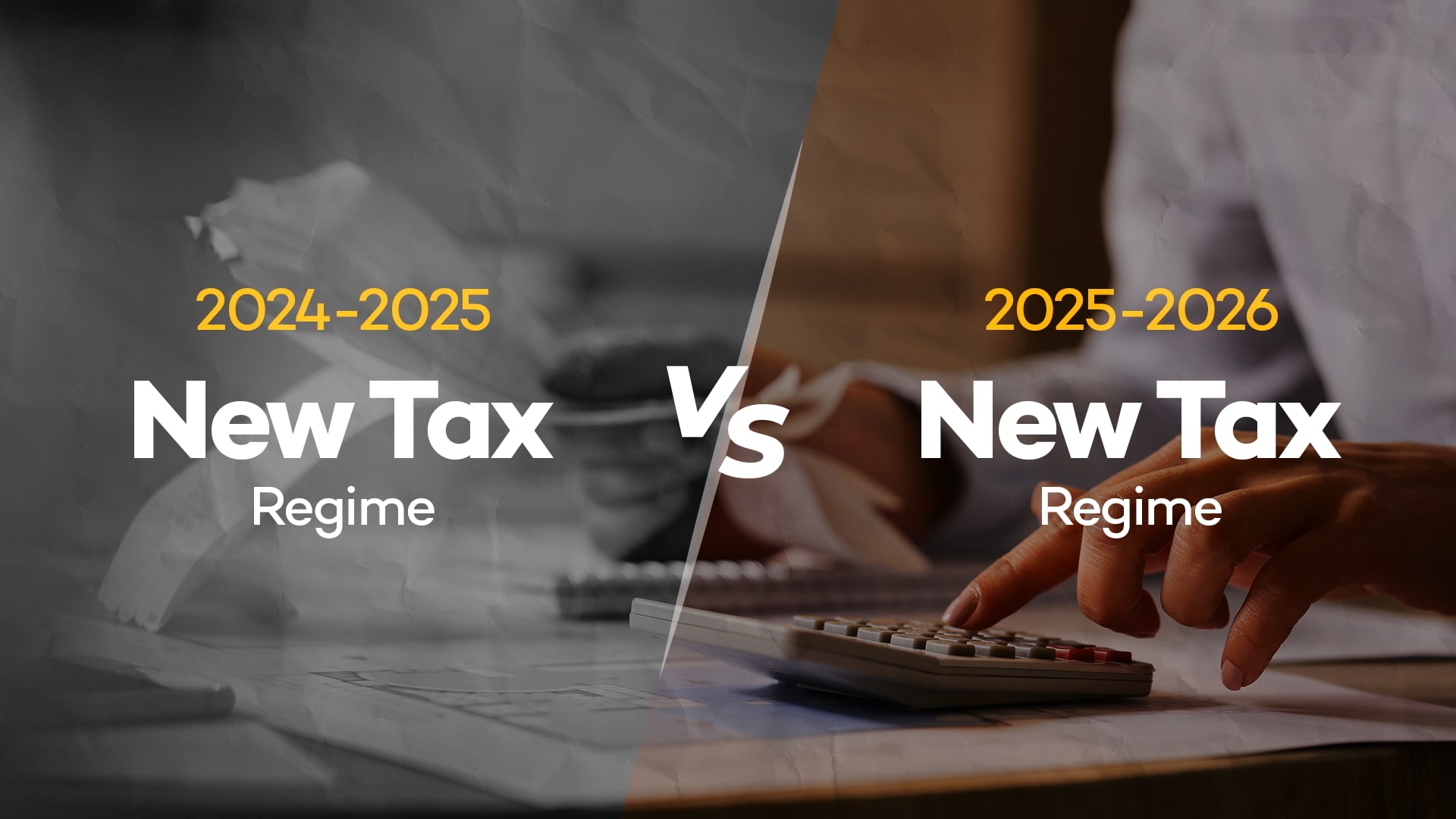Key Highlights of Union Budget 2025
- Zero Tax up to ₹12.75 Lakh (Salaried Under New Regime)
- Under the new regime, the basic exemption limit is ₹12 lakh for all individuals.
- Salaried taxpayers get a ₹75,000 standard deduction, effectively making ₹12.75 lakh income tax-free.
- New Income Tax Slab Rates: The new regime has 7 slabs, starting from 0% for income up to ₹4 lakh and going up to 30% for income above ₹24 lakh.
- Old Income Tax Slabs Unchanged: The old regime continues with the same slabs:
- 0% up to ₹2.5 lakh
- 5% from ₹2.5 lakh to ₹5 lakh
- 20% from ₹5 lakh to ₹10 lakh
- 30% above ₹10 lakh
- Minimal Deductions in the New Regime: The new regime has very few deductions, no HRA, LTA, Section 80C (for investments), Section 80D (medical insurance). The only deduction is the standard deduction of ₹75,000 for salaried individuals
The Union Budget 2025 has introduced a new tax regime for FY 2025-26, bringing fresh changes to how individuals calculate their taxes. While the tax structure for FY 2024-25 remains unchanged, the latest updates could impact your take-home income and overall tax liability.
Whether you’re a salaried professional or self-employed, understanding these changes and making the right choice is crucial for optimizing your taxes and maximizing savings.
This in-depth guide breaks down the new tax regime for FY 2025-26 and, with the help of our income tax calculator, helps you compare your options to find the best way to maximize your take-home salary.
Income Tax Slabs Under New Tax Regimes (FY2024-25 & FY2025-26)
New Tax Regime – FY 2024-25
Under the new tax regime, most exemptions and deductions are not applicable, but the tax rates are lower.
| Income Slabs (₹) | Tax Rate |
| Up to ₹3,00,000 | 0% |
| ₹3,00,001 – ₹7,00,000 | 5% |
| ₹7,00,001 – ₹10,00,000 | 10% |
| ₹10,00,001 – ₹12,00,000 | 15% |
| ₹12,00,001 – ₹15,00,000 | 20% |
| Above ₹15,00,000 | 30% |
New Tax Regime – FY 2025-26 (Revised Slabs)
From FY 2025-26, the government has introduced revised tax slabs under the new tax regime, further reducing tax rates for certain income brackets.
| Income Slabs (₹) | Tax Rate |
| Up to ₹4,00,000 | 0% |
| ₹4,00,001 – ₹8,00,000 | 5% |
| ₹8,00,001 – ₹12,00,000 | 10% |
| ₹12,00,001 – ₹16,00,000 | 15% |
| ₹16,00,001 – ₹20,00,000 | 20% |
| ₹20,00,001 – ₹24,00,000 | 25% |
| Above ₹24,00,000 | 30% |
Deductions & Exemptions Under Both Regimes
The new tax regime offers lower tax rates but restricts most deductions. However, some benefits are still available:
✔ Standard Deduction: ₹75,000 for salaried employees
✔ Section 24(b): Deduction on home loan interest for rented properties
✔ Employer Contribution to NPS under Section 80CCD (1B) (up to 14% of salary)
✔ Transport Allowance for disabled individuals
✔ Conveyance Allowance for work-related travel expenses
✔ Deduction for Family Pension under Section 57(iia) (Up to ₹25,000 or 1/3rd of pension, whichever is lower)
✔ Corpus Fund deductions under Section 80CCH
New Tax Regime Calculator – FY 2024-25 Vs FY 2025-26
Figuring out which regime works best for you can be tricky, which is why using our old vs new tax regime calculator can be incredibly helpful. Compare your tax liability under both systems, taking into account your income and eligible deductions, so you can make an informed decision.
How to Calculate Income Tax Under the New Tax Regimes with Example
Calculating income tax under the New Tax Regimes involves considering income from all sources, applicable exemptions, and deductions. Here’s how you can compute your tax liability:
Income Sources to Include:
- Income from Salary – Basic pay, allowances, bonuses, etc.
- Income from House Property – Rental income or property-related deductions.
- Income from Capital Gains – Profits from selling assets like stocks or real estate.
- Income from Business/Profession – If applicable.
- Income from Other Sources – Interest on savings, fixed deposits (FDs), etc.
Income Tax Calculation for Salaried Individuals
- Basic Salary + HRA + Special Allowance + Transport Allowance + Other Allowances
- Exemptions: Certain components like telephone bill reimbursement and Leave Travel Allowance (LTA) may be exempt from tax.
- Standard Deduction: A standard deduction of ₹75,000 is applicable under the New Tax Regime.
Let’s understand this with an example:
Priya’s Salary & Allowances:
- Basic Salary: ₹1,00,000/month → ₹12,00,000 annually
- HRA (House Rent Allowance): ₹50,000/month → ₹6,00,000 annually
- Special Allowance: ₹21,000/month → ₹2,52,000 annually
- LTA (Leave Travel Allowance): ₹20,000 annually
- Rent Paid: ₹40,000/month → ₹4,80,000 annually (Living in Delhi)
P.S: How to calculate HRA?
HRA exemption is calculated as the minimum of:
- Actual HRA received from your employer.
- 50% of the Basic Salary (for metro cities) or 40% of the Basic Salary (for non-metro cities).
- Actual Rent Paid – 10% of Basic Salary.
How to calculate LTA?
LTA exemption is limited to actual travel expenses incurred for domestic trips only and can be claimed twice in a 4-year block.
Nature of Income Breakdown
| Nature | Amount (₹) | Exemption/Deduction (₹) | Taxable Income (New Regime) (₹) |
| Basic Salary | 12,00,000 | – | 12,00,000 |
| HRA | 6,00,000 | 3,60,000 | 6,00,000 |
| Special Allowance | 2,52,000 | – | 2,52,000 |
| LTA | 20,000 | 12,000 | 20,000 |
| Standard Deduction | – | – | 75,000 |
| Gross Total Salary | 19,97,000 |
Other Income Sources:
- Savings Account Interest: ₹8,000
- Fixed Deposit Interest: ₹12,000
Tax Calculation Under New Regime for FY 2025-26
- Income from salary: ₹19,97,000
- Less: Standard Deduction: (-₹75,000)
- Income from Other Sources: (+₹20,000)
- Gross Total Income: = ₹19,42,000
Total Tax Calculation Under New Regime
- Total tax (including cess): Approximately ₹2,83,504.
Takeaways:
- Under the New Tax Regime for FY 2025-26, higher taxable income but no exemptions/deductions available for claims results in a slightly higher tax liability compared to previous years.
FAQ's
1. What is the difference between the Financial Year (FY) and Assessment Year (AY)?
The Financial Year (FY) is the year in which you earn your income, while the Assessment Year (AY) is the year in which you file your tax return and pay taxes on the income earned in the previous FY.
2. What is a tax rebate, and how does it differ under both regimes?
A tax rebate reduces your tax liability if your income falls below a certain threshold.
- FY 2024-25: ₹5 lakh (Old Regime) | ₹7 lakh (New Regime)
- FY 2025-26: ₹5 lakh (Old Regime) | ₹12 lakh (New Regime)
This means individuals earning up to these amounts pay zero tax under the respective regimes.
3. How does the tax regime affect Non-Resident Indians (NRIs)?
- NRIs are not eligible for tax rebates under Section 87A.
- New Regime: Income above ₹3 lakh (FY 2024-25) and ₹4 lakh (FY 2025-26) is taxable.
4. What is the maximum non-taxable income limit?
- New Tax Regime: Income up to ₹4 lakh is non-taxable.
- Individuals earning up to ₹12 lakh can claim a rebate under Section 87A, making their tax liability zero.
5. What deductions are available under the New Tax Regime?
Unlike the old regime, the new tax regime offers limited deductions, including:
✔ Standard Deduction: ₹75,000 for salaried individuals & pensioners
✔ employer’s contribution to NPS (Section 80CCD(1B))
✔ Interest on home loans (Section 24(b)) for rented properties
✔ Certain allowances for conveyance, transport, and daily expenses
Payroll Solutions Unrivalled since 15 Years


Mukul Dixit is a Growth Marketing Associate with 7+ years of experience creating impactful content in Innovative Tech, SaaS, and HR. A curious explorer at heart, he’s always on the lookout for new cultures to experience, fresh music to vibe, and innovative business ideas to dive. Passionate about entrepreneurship and digital marketing, Mukul brings a creative edge to everything he does.







